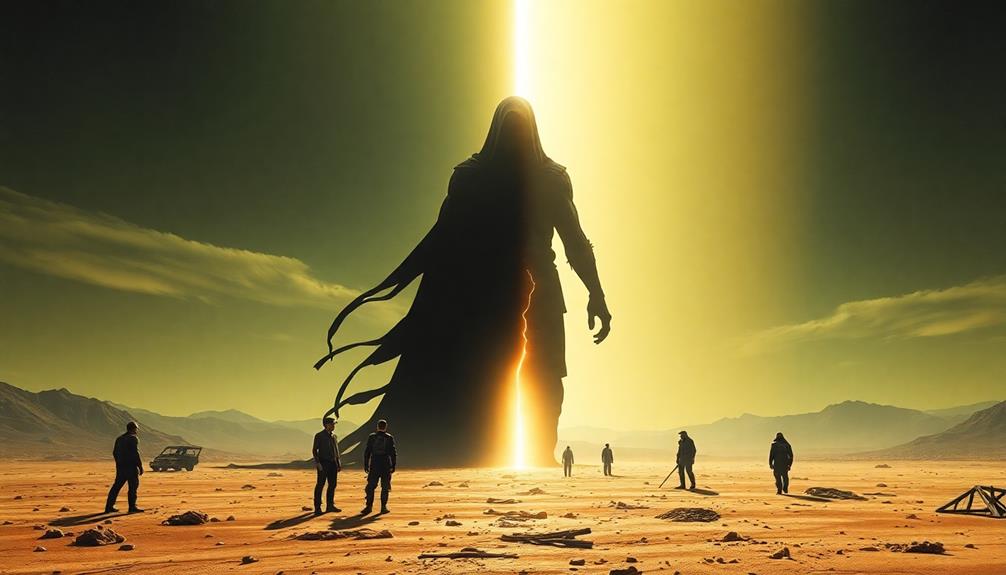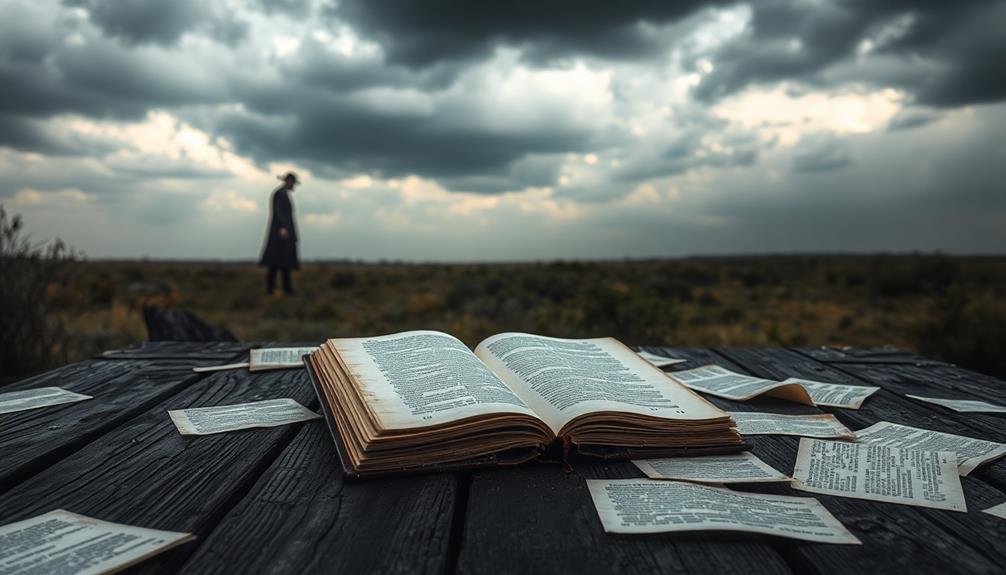Stephen King, a renowned author known for his gripping narratives, wrote *The Stand*, which first hit bookshelves in 1978. This epic novel explores a post-apocalyptic world devastated by a deadly flu virus called *Captain Trips*. You'll meet unforgettable characters like Mother Abagail and Randall Flagg, who embody the struggle between good and evil. The story's rich themes resonate with readers, showcasing moral complexities and the human spirit. Since its release, *The Stand* has garnered critical acclaim and multiple adaptations. If you're intrigued, there's so much more to discover about its impact and legacy.
Publication History and Editions
Stephen King's *The Stand* has undergone significant changes since its initial release in 1978. Originally published in an abridged form, it faced challenges due to its numerous characters and complex storylines, much like the intricate character dynamics seen in Dickens' *Great Expectations* social class themes.
The setting was initially placed in 1980, but you'll notice that this changed with the release of the *Complete & Uncut Edition* in 1990. This edition restored over 400 pages of text, shifting the timeline to 1990 while updating cultural references, making it resonate more with contemporary readers.
In 1980, the first paperback edition appeared, revising the setting to 1985, which contributed to its widespread popularity. This novel became Stephen King's longest stand-alone work, spanning 1,152 pages and solidifying its place in the horror genre.
A limited Coffin Box edition also made waves, featuring signed copies and illustrations, appealing to collectors.
Most recently, Anchor Books published the *Complete & Uncut Edition* in 2012, catering to both long-time fans and newcomers alike.
The publication history of *The Stand* showcases its evolution and enduring significance in literature, making it a must-read for any horror enthusiast.
Critical Reception and Cultural Impact
While *The Stand* received widespread acclaim upon its release, its impact has only deepened over the years. This epic novel by Stephen King quickly achieved #1 bestseller status, selling around 4.5 million copies and solidifying its position as one of King's most successful works. Critics have consistently praised *The Stand*, often placing it on "best books of all time" lists from prestigious publications like *Rolling Stone*, *Time*, and the BBC. Its nomination for the World Fantasy Award for Best Novel in 1979 underscores its significance in fantasy literature.
The narrative's exploration of moral complexities and its vivid portrayal of a post-apocalyptic world further enhance its critical reception, making it a compelling read for audiences. Themes such as good versus evil resonate throughout the story, adding to its depth and intrigue.
The cultural impact of *The Stand* extends beyond the pages of the book. It has inspired various musical works across genres, revealing how its themes and characters resonate with audiences. In a 2003 BBC poll, *The Stand* even ranked number 53 on The Big Read, highlighting its enduring popularity among readers.
This novel's exploration of good versus evil, survival, and human nature continues to captivate new generations, proving that the rich tapestry of its narrative remains relevant in today's world. Stephen King's *The Stand* is more than just a story; it's a cultural touchstone.
Plot Overview and Themes

In *The Stand*, a catastrophic influenza outbreak known as Captain Trips decimates the global population, leaving only a small group of immune survivors to navigate the chaos. Stephen King weaves a tale of survival and resilience as these survivors, led by the wise Mother Abagail, attempt to rebuild society in Boulder, Colorado.
This struggle for survival echoes the bravery demonstrated by ordinary individuals in historical resistance movements, showcasing that even in dire circumstances, acts of courage and defiance can shine through. Meanwhile, they face the dark forces of Randall Flagg, who establishes a malevolent regime in Las Vegas.
The plot explores deep into profound themes, particularly the struggle of good versus evil. As the survivors confront societal breakdown, their journey reflects the fragility of civilization during crises. Each character grapples with personal tragedies and loss, highlighting the psychological impact of their post-apocalyptic reality.
The climactic conflict between Mother Abagail's group and Flagg's followers symbolizes a cosmic battle that tests moral complexities and the human spirit's resilience in the face of overwhelming darkness.
Ultimately, *The Stand* serves as a cautionary tale about humanity's capacity for both destruction and hope, urging readers to reflect on the choices that define us in times of crisis.
Key Characters and Inspirations
*The Stand* features a rich tapestry of characters, each representing different facets of humanity and its struggle for survival. At the heart of the narrative is Mother Abagail, a spiritual leader who symbolizes hope for the survivors. In stark contrast, you have Randall Flagg, the charismatic antagonist whose reign in Las Vegas embodies chaos and malevolence, capturing the darker aspects of the human condition.
The complexity of these characters mirrors the resilience displayed by individuals in dire circumstances, much like Liesel's spirit in *The Book Thief*, who embodies hope amidst oppression.
Stuart Redman stands out as an immune survivor who becomes essential in the rebuilding efforts, showcasing resilience and leadership amid the crisis. You can't overlook Frannie Goldsmith, a pregnant college student maneuvering personal struggles while contributing to the dynamics of the survivor community. Her journey highlights the complexities of love and responsibility during such turmoil.
Then there's the Trashcan Man, a pyromaniac whose evolution into a crucial character for Flagg illustrates the diverse backgrounds and moral conflicts within the survivor group.
King drew inspiration from real-life events, like the case of Patty Hearst, and works like George R. Stewart's *Earth Abides*, crafting a narrative that reflects civilization's fragility and the resilience of the human spirit under extreme circumstances.
Adaptations and Production Details

Adapting *The Stand* into various formats has allowed audiences to experience Stephen King's epic narrative in new ways. The first major adaptation was a television miniseries in 1994, directed by Mick Garris, which ran for eight hours and closely followed the novel's storyline.
In addition to its gripping narrative, the miniseries was celebrated for its engaging performances and production design, reminiscent of the enchanting atmospheres found in unique bookstores like the best book stores in London.
In 2020, CBS All Access produced a second miniseries that spanned ten hours, featuring a fresh cast and updated elements to resonate with modern viewers.
In addition to these miniseries, Marvel Comics brought *The Stand* to life in graphic novel form from 2008 to 2012, with Roberto Aguirre-Sacasa on screenwriting duties and Mike Perkins illustrating the series.
Early attempts to adapt the story for film in the 1980s faced significant hurdles, particularly with George A. Romero's involvement. The networks hesitated due to the challenging end-of-the-world themes inherent in the narrative.
Stephen King actively participated in the adaptations, overseeing production details and contributing to the screenwriting processes. His involvement guaranteed that the essence of *The Stand* remained intact, allowing both new and long-time fans to connect with the epic novel in diverse formats.
Conclusion
In exploring Stephen King's "The Stand," you've journeyed through a post-apocalyptic landscape where darkness battles light, and hope flickers like a candle in the wind. You've seen how vibrant characters emerge from the ashes, each leaving an indelible mark on the narrative. As you close the book, you feel the haunting echoes of their struggles and triumphs, reminding you that even in despair, the human spirit can shine brighter than the sun breaking through a stormy sky.



